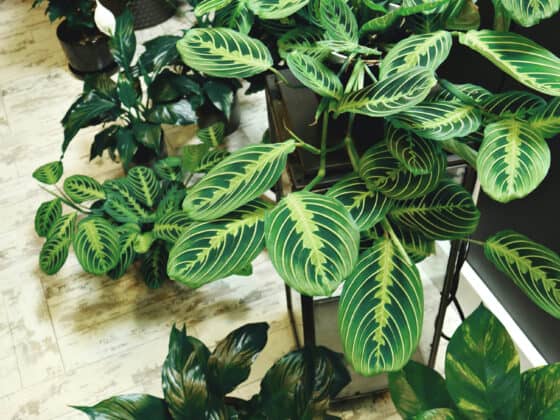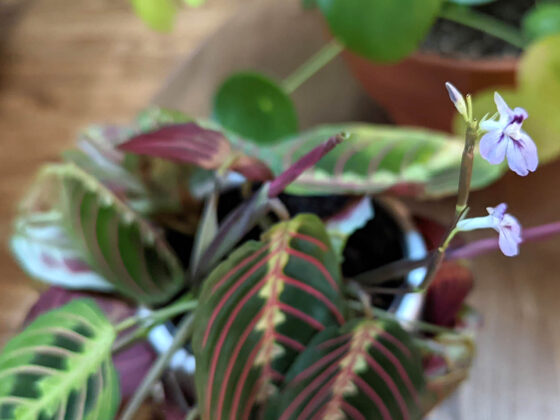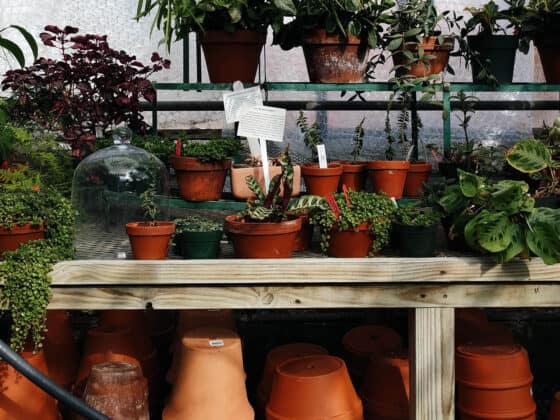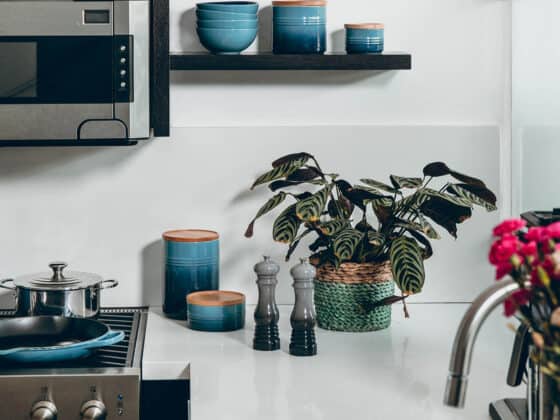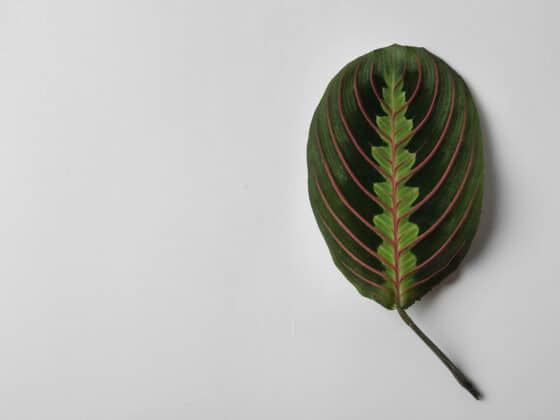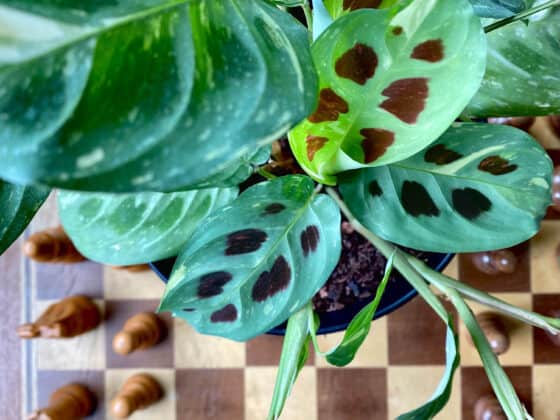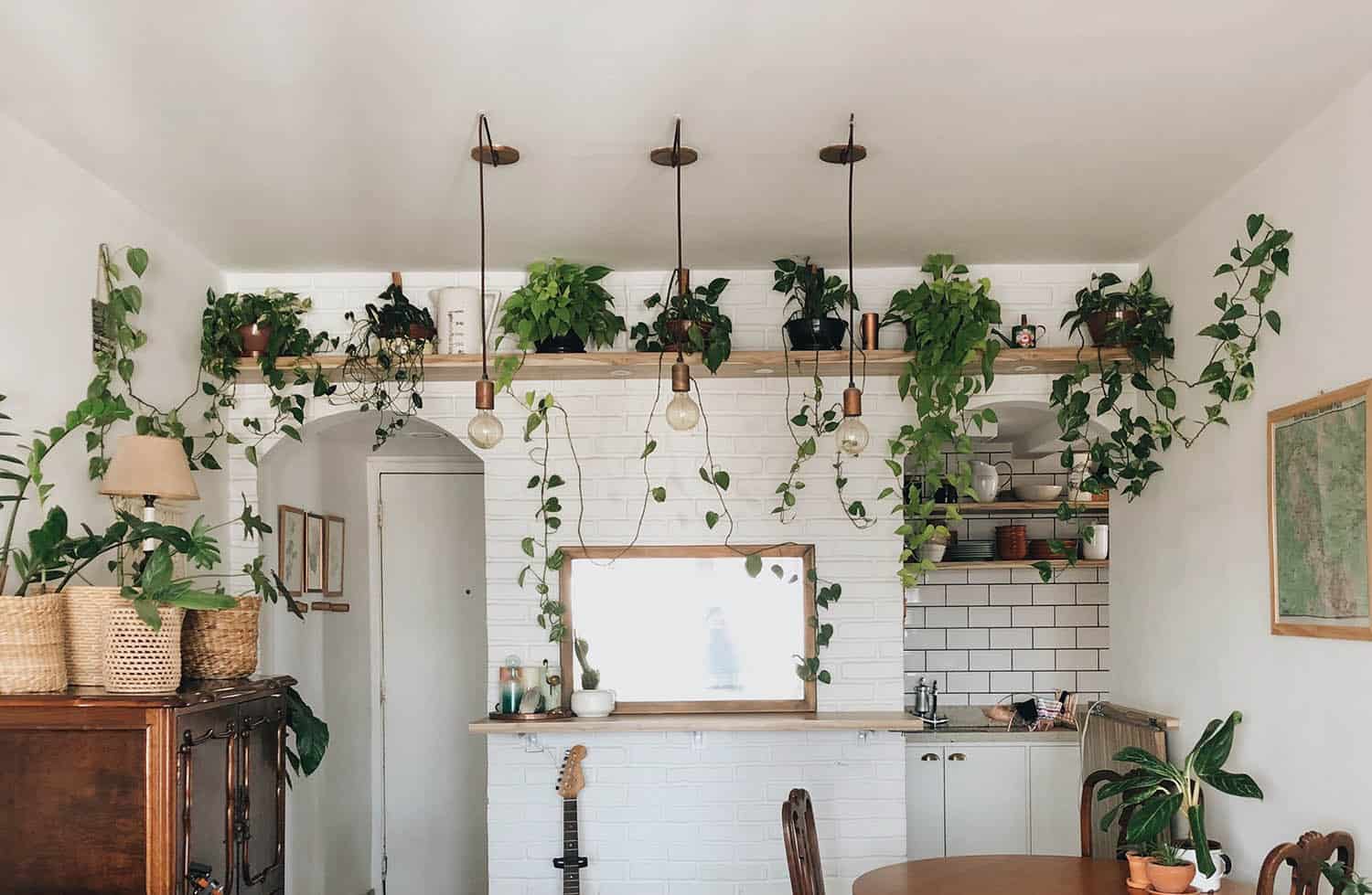Prayer Plants, known scientifically as Maranta leuconeura, are low-growing tropical plants native to South America. In their natural habitats, they grow near to the ground and form clumps of greenery. Prayer Plants come in all shapes and colors, featuring showstopping patterns that make these a delightful plant to have in any home. So, how does a Maranta grow? And how can you display them?
Prayer Plants naturally grow along the ground. Because of the nature of their root systems, Prayer Plants are considered creepers, and they will do well in containers that encourage this. A Prayer Plant will trail and vine in the right conditions but won’t climb up any supports. These plants will do well in both seated and hanging pots.
If you’re trying to find a spot for a Prayer Plant that is new to you, or you have an old faithful friend that you’re considering relocating, there are some places that are better suited than others. This article will talk about how Prayer Plants grow and what they need to thrive. Keep reading to learn about all this and the best way to display them!
Is a Prayer Plant a Vine?
In the wild, Prayer Plants are considered a type of ground cover. They form short, dense clumps along the rainforest floor. Because they reproduce through budding, a kind of asexual reproduction, they behave similarly to many vines.
Despite sharing a lot of traits, Prayer Plants aren’t climbing vines. They are considered trailing vines or creepers. These lack the ability to climb up supports, like trellises or trees, but still spread similarly. Technically, Prayer Plants are a variety of plants known as “creeping rootstalk.” This refers to their ability to produce new growth from their roots.
Do Prayer Plants Trail? Can You Hang Them?
If they don’t climb, will they still trail? And can you display them in a hanging basket? The answer to both of these questions is yes! Prayer Plants are a perfect candidate for trailing or hanging because of their ability to grow long, flowing stems. In their natural habitats, Prayer Plants trail along the forest floor.
Putting a Prayer Plant in a hanging basket is a great way to get the most out of the plant’s aesthetic appeal. Given enough time, Prayer Plants can develop showy growth that is perfect for hanging.
Will a Prayer Plant Climb?
Despite sharing many traits with climbing vines, a Prayer Plant won’t climb any supports or structures near them. Unlike other tropical plants that have developed ways to climb, Marantas thrive on the forest floor, where they’re shielded from harsh sunlight and have plenty of moisture.
Prayer Plants don’t have any means of climbing a structure. Many climbing plants twine themselves around a support. Others use tendrils with a sticky substance to adhere to the structure they’re climbing up. Prayer Plants don’t have either of these abilities.
Can You Stake a Prayer Plant?
Staking a plant usually involves putting some type of support, like a moss pole, into a plant’s pot to encourage the plant to climb. This works well with climbing plants, like Monsteras, which enjoy both the structure and the added humidity.
Prayer Plants aren’t climbers, however. They prefer to be close to the ground where they can spread well and stay shielded from the stronger rays of sunlight. Because of this, there’s no reason to stake a Prayer Plant. They won’t be able to use the support, even if they are secured to it.
Ideal Growing Conditions for Prayer Plants
When trying to figure out the best conditions for a Prayer Plant, don’t forget that these plants are indigenous to tropical areas. They prefer a home that mimics this environment. Though that can be difficult to achieve, it shouldn’t discourage you from owning a Maranta. There are plenty of ways to adjust your home to accommodate these plants.
Prayer Plants prefer lots of bright, indirect sunlight, similar to other tropical plants. But too much sunlight, usually from direct rays, can bleach or burn the leaves of this plant. This will cause the patterns and colors that make Prayer Plants so coveted to fade or disappear. Remember: these are low-lying rainforest plants. Light tends to be sparse near the ground.
As far as water goes, Prayer Plants like a lot of it! During the growing season of the summer months, it’s best to keep the soil evenly moist. Waterings should be consistent and regular so that the plant doesn’t dry out too much between them. As with any plant, it’s important to avoid letting a Prayer Plant sit in stagnant water. Too much water can result in root rot.
Because they’re tropical plants, Prayer Plants prefer areas of high humidity. This can be difficult to achieve in a home, but there are some changes you can make to increase the humidity around your plant. The best option is almost always to relocate your plant to a brightly lit bathroom or kitchen. These areas generally have higher humidity levels, making them ideal for tropical plants.
Another option is to invest in a humidifier. These can be purchased online and come in a wide range of designs, sizes, and prices. Besides periodically refilling the humidifier, this is an easy, low-effort way to increase the humidity around a Prayer Plant. For information on our recommended humidifiers, read this article.
Pebble trays work similarly but don’t require maintenance or supervision. If you’re worried about either of those things, you can simply add pebbles to the tray that your Prayer Plant sits in, rest the pot on top, and add water!
Besides water, light, and humidity, fertilization is essential when creating ideal conditions for a Prayer Plant. Prayer Plants need regular fertilization, especially during their growing season. It’s recommended to fertilize them every two weeks with a liquid fertilizer diluted to half strength. This is a daunting recommendation to anyone not familiar with chemical fertilizers, so proceed with caution if you’re just beginning to care for plants. Prayer Plants react poorly to overfertilization!
If you would prefer to use something less intense, compost teas can work as alternatives. Keep in mind that this won’t have the same nutritional value as chemical fertilizer. Compost teas can be collected from compost buckets or made using banana peels, so it’s an inexpensive option.
The Best Way to Display Your Maranta Leuconeura
If you’re excited to display your Prayer Plant but aren’t sure how, there are a couple of options that will make your plant stand out.
The simplest, most straightforward way to display a Prayer Plant is in a pot. Placed on a counter or tabletop by itself, a Prayer Plant won’t have to compete for the attention that it deserves. Bonus points if the planter you choose compliments the colors of the leaves! If you’re hesitant about putting the container on a wooden surface (because this can cause water rings), try looking for a raised planter. There are a lot of attractive options for these.
Prayer Plants will also always look fabulous in a hanging planter. It can be challenging to nail lighting and humidity with these because you can’t move the plant as quickly. That’s why it’s key to scope out the spot you’d like to hang your Prayer Plant before drilling anything into place.
If you’ve decided to hang your Prayer Plant, look for a container and hanging apparatus that includes colors from your plant. Macrame plant hangers are popular right now, and there are plenty available on retailers like Etsy. You’ll see plenty of unique options, like knotting patterns and beads, that can integrate well with your décor.
If you’re crafty, there are also a lot of DIY options for plant hangers. This will allow you to customize your plant hangers and won’t cost nearly as much as ordering one online.
Additionally, Prayer Plants can be included in plant displays featuring other tropical plants. While it isn’t a good idea to plant them in the same container, you can arrange your tropical plants together to showcase their beauty! This makes maintaining their humidity levels a little bit easier, too. Just make sure that they share the same needs and that no one has any pests or infections.







